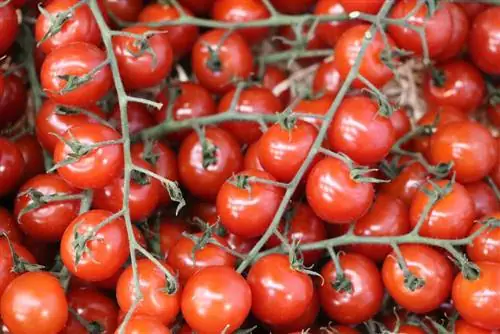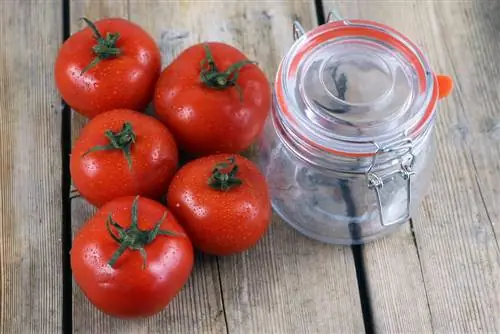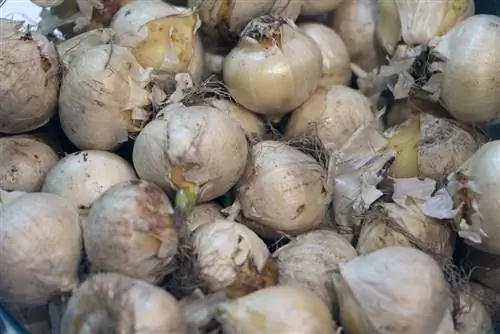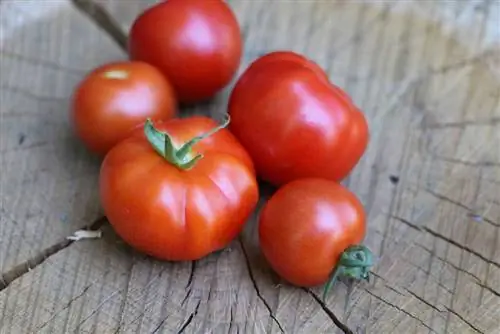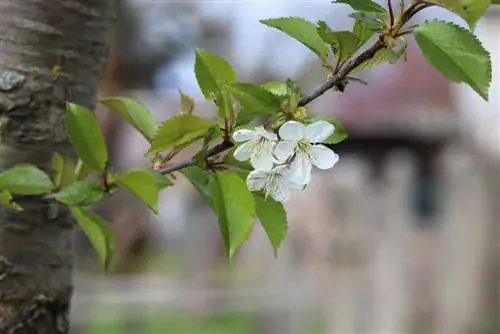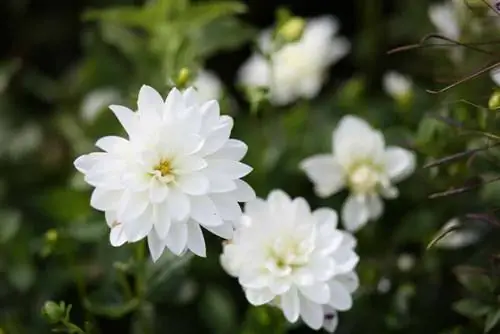- Author admin [email protected].
- Public 2023-12-17 03:39.
- Last modified 2025-01-24 12:45.
Cherry tomatoes or cocktail tomatoes are a popular snack vegetable. They have a particularly intense aroma and a slightly sweet taste. The mini tomatoes are also ideal for salads or pasta dishes and are very easy to grow on the balcony, terrace or in the garden. With our tips on cultivation and care, you don't need a green thumb.
Variety variety
Cherry tomatoes, cherry tomatoes or cocktail tomatoes, as they are also called, are available in numerous different varieties. The fruits differ in size, color, shape and taste. They can be round or egg-shaped, yellow to purple and even striped but also classic red. The weight of the individual fruits is between 10 and 50 grams.
Due to the variety on offer, you can find something that suits everyone's taste. However, more important than the size and shape of the fruits is the suitability of the plants for the intended location. There are also significant differences in the growth form and size of the plants. There are numerous varieties from 40 to 200 centimeters high. While the small varieties are ideal for cultivation in pots or containers and can also be cultivated in the home, the larger plants are ideal for outdoor cultivation.
Location
Regardless of the variety, cherry tomatoes, which belong to the nightshade family, need a lot of light and warmth. They should therefore be given a protected and sunny location. Places next to house walls, wind-protected corners on the balcony or terrace or a location close to a south-facing window are ideal. In any case, the final size of the respective plant must be taken into account.
Substrate
Cherry tomatoes need a loose, nutrient-rich substrate to thrive. A simple option is to use special tomato soil from specialist retailers. However, garden soil mixed with well-rotted compost or potting soil are also suitable. It is important that the soil is loose and allows water to drain well. If the substrate is very clayey or compacted, the soil should be loosened with sand or coconut fibers.
Bucket Culture
Several points should be taken into account when cultivating cherry tomatoes in containers. These are:
Drainage
So that the plants are not exposed to waterlogging, the plants need drainage in the planter. For example, coarser gravel, shards of pottery or even stones at the bottom of the pot are suitable. This drainage layer allows the water to drain away better and prevents the roots from being too submerged in water, which could cause them to rot.
Support
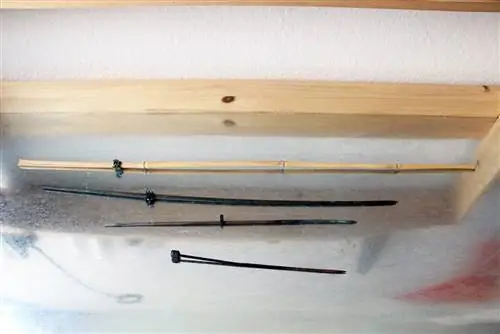
Even the small varieties of cherry tomatoes can produce significant yields. Although the fruits weigh only a small amount individually, they can put a lot of strain on the plant because they grow in a grape-shaped arrangement. Therefore, it is crucial that the plant is supported appropriately. Plant sticks that are used in groups of three or four and connected to each other at the top are suitable.
Height and weight
The planter must be large and heavy enough to ensure stability. For example, clay pots as planters or other planters that have a heavy and wide base are well suited.
Plant outdoors
If the cherry tomatoes are to be planted or placed outdoors, there are also a few points to consider. These are the following factors:
Protection from frost
Even early and strong tomato plants should only be planted outdoors when frost is no longer expected. Normally this only happens after the Ice Saints. In general, the risk of frost depends of course on the respective climate.
Preparing the soil
Since cherry tomatoes require loose soil for ideal growth, the soil in the bed should be loosened before planting. It also makes sense to mix well-rotted compost into the substrate.
Support
As with cultivation in pots, cherry tomatoes planted outdoors should be supported with plant stakes.
Tip:
Instead of having to laboriously dig up the cocktail tomatoes in the fall, they can be planted in plant pots in the bed. This makes it much easier to remove the root ball from the substrate and allow the plants to overwinter safely.
Pouring
Cherry tomatoes require a comparatively large amount of water, although soft, low-lime water should be used. Suitable examples are:
- collected rainwater
- Tap water that could stand for a week
- Water from pond or aquarium
The sediment should not be used with stale tap water, as this contains a large part of the lime. Watering should be done in such a way that the substrate is always kept slightly moist but does not become waterlogged. Loose substrate, a drainage layer and amounts of water as needed are crucial. In addition, waterlogging must urgently be avoided. In summer and outdoors, it should be noted that sometimes two waterings must be given daily. This is especially true when the plants bear numerous fruits.
Fertilize
Cherry tomatoes are so-called heavy feeders. This means that they require relatively large amounts of nutrients. During the growth phase - from March to around the end of August - they must be regularly and generously fertilized. Nutrients still need to be supplied during the winter, but the amount may be lower. Suitable fertilizers include:
- well-rotted compost
- stable manure
- special tomato fertilizer
- Fertilizer for vegetable plants
- Aquarium and pond water
- Plant manure
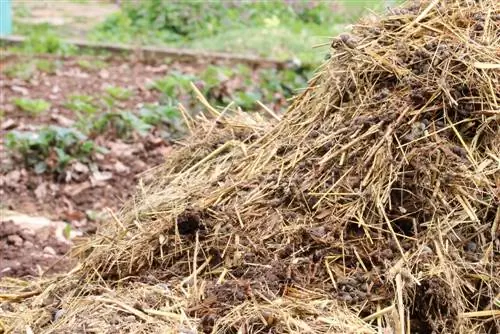
When using ready-made fertilizer from specialist retailers, the manufacturer's instructions should be followed regarding the spacing when fertilizing. With natural fertilizers, a light dose can be given weekly or every two weeks during the growth phase.
Stripping and waste
Tomatoes should generally be maximized so that the plants put most of their energy into producing fruit and not into growing side shoots or stingy shoots. However, things are different with cherry tomatoes. In comparison, the plants grow bushier, shrubby and more expansive. However, they do not require stripping. Side shoots that do not bear buds, flowers or fruit do not need to be removed. However, a waste can still be useful. For example, in the following cases:
- if shoots are damaged or withered
- if the plant threatens to break despite supporting plant stakes
- if individual sections are affected by diseases or pests and further spread should be prevented
When making any cut on the cherry tomato, it is important to pay attention to the following points:
Use clean cutting tool
Ideally, the blades of knives or scissors are disinfected before and after cutting. This prevents the transmission of parasites and pathogens.
Sharp Blades
To ensure that the cut surfaces on the plant do not tear out, become irregular or become bruised, the blades of the cutting tool should be sharp. This is the only way to create clean and smooth cutting surfaces.
Carry out cutting at the right time
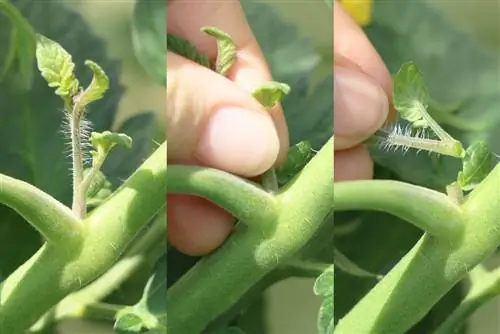
If there is an infestation with diseases or pests, cutting should be done as quickly as possible. Even then, it is more advisable to choose a dry and sunny day for the care measure. In these conditions, cut surfaces dry more quickly, reducing the risk of disease spread and invading parasites.
Wintering
Since the cherry tomatoes cannot tolerate frost, they must be kept indoors over the winter. There are two options for this. On the one hand, simply moving the plants to an area that is frost-proof and as bright as possible. On the other hand, overwintering as cuttings. When overwintering cherry tomatoes, the following points should be taken into account:
- Temperatures of 20-24°C are ideal
- Watering and fertilizing should continue to be adjusted
- the plants need as much light as possible
Light is particularly an important factor. Temperature as well as water and nutrients can be easily provided - but natural light in winter is usually not enough, even in a south-facing location near a window. It therefore makes sense to use a plant lamp. The warmer the plants are, the warmer it has to be. Otherwise damage to the plants will occur.
Propagation
Cherry tomatoes can be propagated via seeds and cuttings. Both variants are comparatively easy as long as the correct procedure is followed. When propagating by seeds, these steps are required:
- The seeds and pulp are removed from the tomatoes in question.
- The pulp and seeds are either washed and separated from each other in a fine-mesh tea strainer or covered and soaked in a glass of water and washed thoroughly after about a day. Soaking should cause the husks to separate from the seeds.
- The seeds are dried and then stored in a cool, dry and dark place. Advancement can take place from February.
- After storage, the seeds are placed in potting soil and only lightly covered with the substrate. The soil is well moistened, but should not be wet.
- The cultivation containers are placed in a warm and bright location and covered with either foil or a glass pane. The cover should be removed daily and the planter ventilated to prevent mold from forming.
- The substrate must be kept moist throughout. When the plants have reached a height of around ten centimeters, they can be transplanted into nutrient-rich soil.
Tip:
It is of course easier to purchase seeds commercially or to buy pre-grown plants. When plants are grown early, care should be taken to ensure that they have dark green leaves and strong shoots.
Typical diseases, pests and care errors
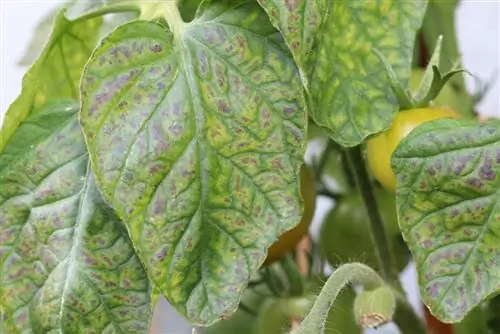
In order for the cherry tomatoes to thrive and last for several years, appropriate care must be taken and care must be taken to ensure that pests and diseases do not spread. Typical problems include:
Too much water, waterlogging or lack of water
Excessive watering and waterlogging can cause the roots to rot, mold to form on the substrate and the plant to die for seemingly inexplicable reasons. However, too little water can cause the tomato fruits to burst or fall off. In the case of brown, dry or wilted leaves and problems with the fruits, the watering behavior and the condition of the substrate should always be examined.
Lack of nutrients
Another typical care mistake for cherry tomatoes is that they are not supplied with enough nutrients. It is ideal to alternate the fertilizers and fertilize regularly even during the winter. Only if the heavy eaters are adequately cared for are they resistant to diseases and parasites and can thrive accordingly.
Fungal diseases
Fungal diseases mainly occur when the plants are too close together and therefore there is not enough ventilation. Excessive humidity or a lack of water can also be triggers. However, diseases such as powdery mildew and downy mildew can usually be easily controlled with home remedies or commercial fungicides.
Pests
Nematodes, spider mites and whiteflies can attack cherry tomatoes and create web-like deposits as well as feeding marks on the leaves. Natural enemies such as predatory bugs, ladybirds, spiders and parasitic wasps are recommended for plants grown outdoors. However, other remedies can also be found commercially, such as yellow plugs and adhesive traps against the parasites.

